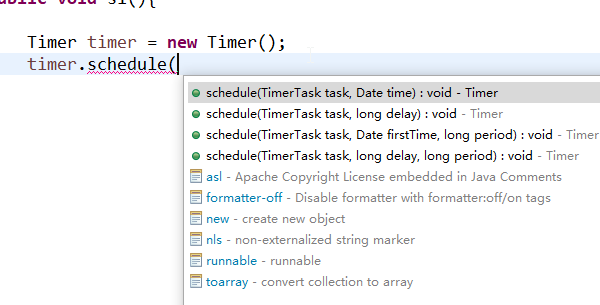Timer 原理 到 spring 定时器任务
Java Timer 怎么实现延时任务的?怎么实现周期任务的?消耗资源多吗?执行时间准确吗?
1 Timer 的基本使用。

第一个参数是任务,第二个参数可以是指定时间,第三个参数如果指定了就会周期的执行这个任务
2 Timer 的原理
概述:Timer 有一个内部线程,和一个任务队列,在Timer 执行下一个任务之前会wait指定时间,在Timer 里面任务队列是空的时候会无限期wait,然后再再新加入任务(2分查找找到插入位置)的以后弹出需要最近执行的一个任务,并且唤醒阻塞的循环消费任务的线程。在循环消费任务的线程中,如果任务是周期任务那么就计算出下一个执行时间点,然后把它插入到按照时间排序的队列中(插入过程使用2分查找),然后判断当前任务是否到了激活时间,如果到了就执行,如果没到就睡到指定时间。
源码解析:
1 添加任务以后判断了延时时间不能是负数,然后调用 sched

2 sched 方法,做了一些判断断,然后拿到任务队列的锁,然后阻塞用队列的添加方法,添加完成以后,判断如果当前新加入的任务是排最前面的,那么就唤醒任务线程。
private void sched(TimerTask task, long time, long period) {
if (time < 0)
throw new IllegalArgumentException("Illegal execution time.");
// Constrain value of period sufficiently to prevent numeric
// overflow while still being effectively infinitely large.
if (Math.abs(period) > (Long.MAX_VALUE >> 1))
period >>= 1;
synchronized(queue) {
if (!thread.newTasksMayBeScheduled)
throw new IllegalStateException("Timer already cancelled.");
synchronized(task.lock) {
if (task.state != TimerTask.VIRGIN)
throw new IllegalStateException(
"Task already scheduled or cancelled");
task.nextExecutionTime = time;
task.period = period;
task.state = TimerTask.SCHEDULED;
}
queue.add(task);
if (queue.getMin() == task)
queue.notify();
}
}
3 任务队列的添加方法,判断是否需要拓容,通过二分查找下一次执行时间,找应该插入的位置
void add(TimerTask task) {
// Grow backing store if necessary
if (size + 1 == queue.length)
queue = Arrays.copyOf(queue, 2*queue.length);
queue[++size] = task;
fixUp(size);
}
private void fixUp(int k) {
while (k > 1) {
int j = k >> 1;
if (queue[j].nextExecutionTime <= queue[k].nextExecutionTime)
break;
TimerTask tmp = queue[j]; queue[j] = queue[k]; queue[k] = tmp;
k = j;
}
}
4循环任务,循环过程,如果任务队列是空就等着(直到添加元素后唤醒它),醒了 以后取出最上面的任务,获取任务锁,如果任务取消,直接下跳过,比对当前时间和执行时间,判断任务是否激活,没激活就等到需要激活的时间,
如果激活了,如果是普通任务,直接从队里里面删除,修改执行状态,如果是循环任务,那么计算出下次执行时间,并且在队列里面重排序这个任务,最后调用这个任务 run 方法。
private void mainLoop() {
while (true) {
try {
TimerTask task;
boolean taskFired;
synchronized(queue) {
// Wait for queue to become non-empty
while (queue.isEmpty() && newTasksMayBeScheduled)
queue.wait();
if (queue.isEmpty())
break; // Queue is empty and will forever remain; die
// Queue nonempty; look at first evt and do the right thing
long currentTime, executionTime;
task = queue.getMin();
synchronized(task.lock) {
if (task.state == TimerTask.CANCELLED) {
queue.removeMin();
continue; // No action required, poll queue again
}
currentTime = System.currentTimeMillis();
executionTime = task.nextExecutionTime;
if (taskFired = (executionTime<=currentTime)) {
if (task.period == 0) { // Non-repeating, remove
queue.removeMin();
task.state = TimerTask.EXECUTED;
} else { // Repeating task, reschedule
queue.rescheduleMin(
task.period<0 ? currentTime - task.period
: executionTime + task.period);
}
}
}
if (!taskFired) // Task hasn't yet fired; wait
queue.wait(executionTime - currentTime);
}
if (taskFired) // Task fired; run it, holding no locks
task.run();
} catch(InterruptedException e) {
}
}
}
3 什么情况下Timer 应该避免怎么用
因为一个Timer 里面有一个 线程,如果我们有多个延时任务,多种不同周期的任务时,我们应该考虑使用少量或者一个TImer,而不是每种甚至每个任务都创建一个Timer,避免大量资源浪费在多线程上下文切换只上。
4 spring @Scheduled 的定时任务和 实现了 SchedulingConfigurer 的 定时任务
他们都支持 cron ,这种定时器原理其实类似于Timer 周期执行,在执行当前任务的时候通过 cron 计算出 下一次执行的时间,然后插入到 任务队列的指定位置就行了。使用 SchedulingConfigurer自定义定人任务的时候同样 要避免太过大量的创建 SchedulingConfigurer 的个数,避免太多线程上下文切换带来的消耗。
能耍的时候就一定要耍,不能耍的时候一定要学。
--天道酬勤,贵在坚持posted on 2022-05-24 21:55 zhangyukun 阅读(196) 评论(0) 收藏 举报



 浙公网安备 33010602011771号
浙公网安备 33010602011771号